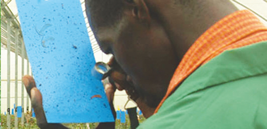 Kenya’s European Union (EU) market share is about 38%
Kenya’s European Union (EU) market share is about 38%
Kenya’s flower industry is the oldest and largest in Africa contributing 1.29% of the national GDP. The sector has continued to record growth in volume and value of cut flowers exported every year. According to Kenya National Bureau of Statistics in 2013, the floriculture industry exported 124, 858 tons valued at Kshs 46.3 billion. It is estimated that over 500,000 people, including over 90,000 flower farm employees depend on the floriculture industry.
The main production areas are around Lake Naivasha, Mt. Kenya, Nairobi, Thika, Kiambu, Athi River, Kitale, Nakuru, Kericho, Nyandarua, Trans Nzoia, Uasin Gichu, Kajiado and Eastern Kenya.
Kenya is the lead exporter of rose cut flowers to the European Union (EU) with a market share of about 38%. In the United Kingdom, supermarkets are the main retail outlets. Other growing destinations include Japan, Russia and USA.

 Going by the investment trends of the last couple of years, one is left to ask this simple question. Is Kenya shifting to the auction like markets while moving away from the auctions?
Going by the investment trends of the last couple of years, one is left to ask this simple question. Is Kenya shifting to the auction like markets while moving away from the auctions? A marketing guy in a flower farm asked me the other day what the greatest marketing challenges facing flower business today were and whether I think these challenges are different than they have been historically. That’s a great question and I’ve pondered it for a while.
A marketing guy in a flower farm asked me the other day what the greatest marketing challenges facing flower business today were and whether I think these challenges are different than they have been historically. That’s a great question and I’ve pondered it for a while. About two million Kenyans are food insecure. In Nairobi, up to 20 per cent of the population is ultra hungry, researchers tell us. Farmers responsible for feeding the country are still struggling with access to seeds, government subsidized agro inputs, diseases and pests and emerging threats like climate change.
About two million Kenyans are food insecure. In Nairobi, up to 20 per cent of the population is ultra hungry, researchers tell us. Farmers responsible for feeding the country are still struggling with access to seeds, government subsidized agro inputs, diseases and pests and emerging threats like climate change. Thrips, order Thysanoptera, are tiny, slender insects with fringed wings. They feed by puncturing the epidermal (outer) layer of host tissue and sucking out the cell contents, which results in stippling, discolored flecking, or silvering of the leaf surface. Thrips feeding is usually accompanied by black varnishlike flecks of frass (excrement).
Thrips, order Thysanoptera, are tiny, slender insects with fringed wings. They feed by puncturing the epidermal (outer) layer of host tissue and sucking out the cell contents, which results in stippling, discolored flecking, or silvering of the leaf surface. Thrips feeding is usually accompanied by black varnishlike flecks of frass (excrement). The crop protection industry is dominated by the large multinational agro-chemical companies such as Syngenta, Monsanto and Bayer Cropscience. The biocontrol business is minute in comparison, with only 3% of global sales of crop protection products. The future of the biocontrol industry is based on a range of interacting factors and difficult to predict the future, however many are suggesting that its future is likely to grow. There are numerous drivers for the use of biological control.
The crop protection industry is dominated by the large multinational agro-chemical companies such as Syngenta, Monsanto and Bayer Cropscience. The biocontrol business is minute in comparison, with only 3% of global sales of crop protection products. The future of the biocontrol industry is based on a range of interacting factors and difficult to predict the future, however many are suggesting that its future is likely to grow. There are numerous drivers for the use of biological control. Briefly discuss Barnaba Rotich (Background-Personal and a professional)
Briefly discuss Barnaba Rotich (Background-Personal and a professional)